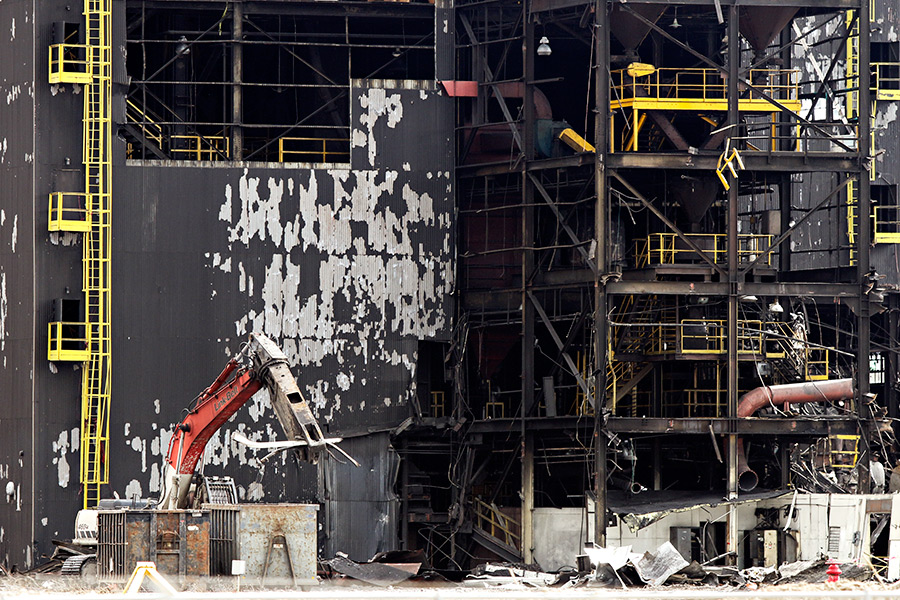EPA, Glencore to Begin Investigating Contamination at CFAC Property
Crews will soon begin drilling wells and establishing sampling sites throughout industrial property
By Dillon Tabish
As crews continue to demolish abandoned buildings and remove leftover materials, the Environmental Protection Agency is gearing up for its official on-site investigation of the Columbia Falls Aluminum Company property.
EPA officials and Glencore engineers are preparing to start work in the coming weeks on a sizeable study that will determine the level of contamination at the large industrial site along the Flathead River. The investigation will include boring over 100 holes up to 12 feet deep to test the soil and drilling 43 new wells with an average depth of 100 feet to test the groundwater. Crews will also install 16 surface-water sampling sites throughout a large swath of land encompassing the surrounding area, including three on Cedar Creek and 10 on the Flathead River.
“We want to make sure we do a really good investigation here,” Mike Cirian, EPA’s remedial project manager, told a crowd of over 40 people inside Columbia Falls City Hall last week.
Cirian updated the community on CFAC’s lengthy and contentious journey from closure to cleanup, a process that is expected to take several years or even decades.
Installing the wells, which will begin May 18, will take roughly one year, Cirian said. Then scientists will begin studying samples from the wells on a quarterly basis and analyze possible contaminants and whether groundwater has been leaving the site, among other surveying.
All together, the remedial investigation will take roughly four years before the EPA has a grasp on the level of contamination throughout the 800-plus acre property, Cirian said.
“We know there is some contamination there. We don’t know how much. We know there’s enough to meet the hazard index on the (National Priorities List),” Cirian said, referencing the register of hazardous waste sites that is a precursor for the Superfund program.
Once the investigation is complete, the EPA will study a range of remedies. Around 2020, the agency could release a list of alternatives for public comment and actual cleanup could begin around 2021, Cirian said.
»»» Click here to view a map of where the remedial investigation will take place.
Cirian emphasized that the site is not currently being cleaned up. Calbag Resources, a Portland, Oregon-based firm that specializes in decommissioning industrial sites, is in the middle of salvaging the site and removing above-ground materials, a process that is expected to take two years.
Separately, the property’s owner, Glencore, has agreed to pay $4 million for the remedial investigation.
“We can’t start the cleanup until we know what’s there,” Cirian said.
The agreement with CFAC has led community members to wonder why the EPA needs to move forward with a Superfund designation, a decision that is expected to be made this fall.
Don Bennett, president of Freedom Bank, asked Cirian why the agency could not hold off on the Superfund listing while Glencore and the EPA investigate the site.
“We’ve got three years and everything is working really well right now. Why can’t we continue the way it is?” Bennett asked.
Community members have expressed concern that designating CFAC a Superfund site will create a stigma that hurts the community and lengthens the cleanup process.
Cirian countered by saying the federal Superfund designation will ensure Glencore properly cleans up the site as swiftly as possible. By waiting until a later date to designate the property, it could delay the process and hamper cleanup efforts both financially and logistically, Cirian said.
“Say we get through the investigation process and we can’t come to terms (with Glencore) on what it will cost to clean it up. If it’s not listed (as a Superfund site), that means we may have to start that whole process over,” Cirian said.
Cirian said he hopes the working relationship with Glencore continues, but if it doesn’t then at least the Superfund program would ensure the cleanup moves forward instead of grinding to a halt.
The EPA also plans to establish a community advisory group in the future that will ensure the public is involved in the cleanup process.
The agency has developed a website with information about the investigation and cleanup process. The Montana Department of Environmental Quality also has a site devoted to CFAC information.
Glencore is also planning to hold a public tour of the CFAC site on May 25. Further information will be released closer to the date asking for RSVP notices to ensure there is enough transportation.